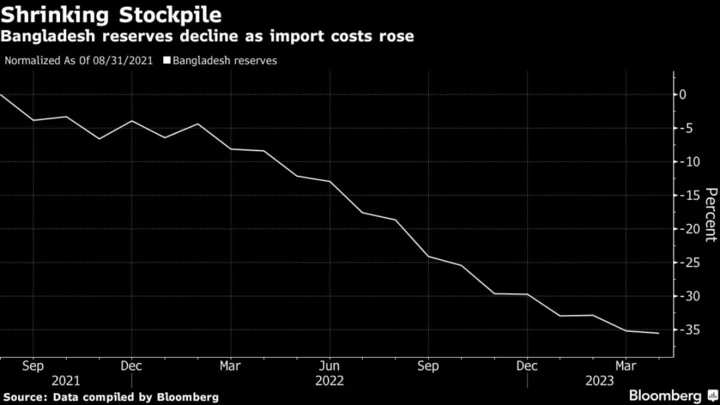Moody’s Investors Service lowered Bangladesh’s credit rating as the nation’s foreign-exchange reserves dwindle while unconventional policies such as multiple exchange rates and interest-rate caps create market distortions.
The rating on the nation’s long-term foreign debt was reduced by one notch to B1, four levels below investment grade, Moody’s said in a statement on Tuesday. The downgrade puts Bangladesh on par with Honduras and below Greece and the Ivory Coast.
“Bangladesh’s heightened external vulnerability and liquidity risks are persistent,” analysts Camille Chautard and Gene Fang wrote. “Despite some easing, ongoing dollar scarcity and deterioration in FX reserves indicate continued pressures on Bangladesh’s external position.”
Bangladesh, whose economy had been hard-hit by surging import costs in recent years, has seen its dollar stockpile shrink by 40% from a peak in August 2021, Moody’s said. The government, which secured a $4.7 billion bailout from the International Monetary Fund in January, is stepping up reforms including raising taxes and unifying its exchange rates.
But Moody’s raised doubts over the speed of progress, saying it expects improvements in revenue collection and tax administration will be slow, considering the nation’s poor track record of implementation as well as administrative and efficiency barriers.
Prime Minister Sheikh Hasina’s government is set on Thursday to present the budget for the fiscal year 2024 that starts from July.. The nation is also moving toward a market-based, flexible and unified exchange rate regime with a 2% variation.
The taka has weakened 4% in the interbank market to about 107 per dollar this year. The South Asian nation has a separate dollar-taka rate for interbank transactions, export proceeds and remittances.
Moody’s Forecasts
- Gross reserves, which stood at $27 billion in April, will remain below $30 billion in the next two to three years
- Fiscal deficit to remain at about 50 to 5.5% of gross domestic product over the next few years
- Debt burden to rise to almost 40% of GDP by end of FY 2026 from below 30% in FY 2022
--With assistance from Arun Devnath.
Author: Karl Lester M. Yap









